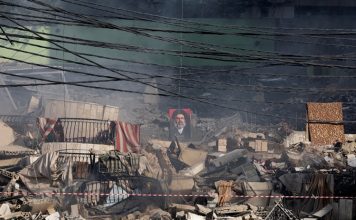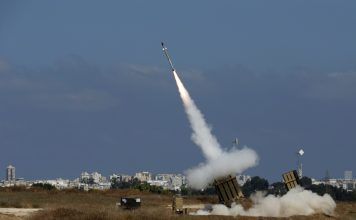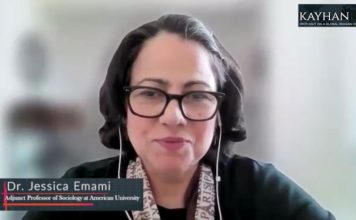The ongoing protests sparked by the death of 22-year-old Mahsa (Zhina) Amini while in the custody of the morality police (guidance patrol) in Tehran on Sept. 16 have spread to 120 cities in some 30 provinces in the past week with no sign of people backing down, despite the brutal crackdown by the Iranian authorities, who have shut down the internet and severely restricted messaging platforms Instagram and WhatsApp.
The size and scale of the nationwide protests have surprised Iranian authorities. Security forces and riot police are said to lack the resources to crack down on the widespread unrest in major cities.
Girls and women of all ages have had a significant presence in recent protests. Iranian state media said on Sept. 21 that the recent unrest marked the first time that authorities used all-female security and police units to crush the protests.
It is becoming increasingly clear that people are not complaining about a particular social, political, cultural, or economic issue but calling for regime change, as is apparent in some slogans, including “this is the year of blood, Seyyed Ali will go,” and “cannons, tanks, bullets, clerics must get lost.”
[aesop_image img=”https://kayhanlife.com/wp-content/uploads/2022/09/2022-09-28T011947Z_90708553_RC2XPW9ZVGK1_RTRMADP_3_IRAN-WOMEN-MEXICO.jpg” panorama=”off” credit=”People hold signs during a protest against the Islamic regime of Iran and the death of Mahsa Amini, outside the Iranian embassy in Mexico City, Mexico, September 27, 2022. ” align=”center” lightbox=”on” captionsrc=”custom” caption=”REUTERS/Paola Garcia” captionposition=”left” revealfx=”off” overlay_revealfx=”off”]
The deployment of riot police, security units, Basij (volunteer militias), and the Islamic Revolutionary Guard Corps (IRGC) forces onto the streets to confront the crowd has transformed the daily protests into a unified national revolution.
Iranian President Ebrahim Raisi’s speech at the UN General Assembly on Sept. 21 coincided with the escalation of the ongoing protests in Iran, sparked by the failure of his hardline government to understand the social, political, and cultural mood of the country and manage the chronic economic crisis that has forced a large segment of the population into poverty in the past decade.
The Islamic Republic officials never imagined that people’s anger could spark nationwide unrest that continues to grow despite the brutal crackdown on protesters by state security and police forces.
The international community’s overwhelming support for protesters and strong condemnation of the regime’s treatment of people demanding their inalienable civil and human rights has surprised Iranian authorities.
The Iranian people’s profound pride in their Persian heritage, ancestry, and history, which the Islamic Republic has never understood and has tried to erase in the past 43 years, has caught Iranian officials off guard. The oaths of Persian mythological heroes like “Siamak” and “Siavash,” personified in the actual person of “Mahsa Amini,” have been a source of inspiration for protesters.
However, recent protests markedly differ from previous ones.
The protests from December 2017 to January 2018 and the summer of 2018, and those in November 2019 were over the government’s failure to manage an economic crisis that caused severe financial hardship for a large segment of the population.
Current protests also differ from those sparked by severe drought in the summer and November 2021 in Khuzestan (southern province) and Isfahan (central province.)
This year’s protests are not about a particular social and economic issue: they are political. They were sparked by the death of Mahsa Amini while in the custody of the morality police. These protests are against the Islamic Republic’s restrictive hijab laws, other discriminatory practices, and the systematic oppression of Iranians.
Although student protests in 1999 and the controversial presidential election of 2009 were motivated by political events, both grew out of infighting among various factions within the regime, ultimately benefiting the reformists.
Current protests are against the Islamic Republic itself.
They are the materialization of the slogan “conservatives, reformists, the end is here,” which was at the core of the December 2018 protest and led to the massive boycott of the 2021 presidential elections.
These protests are devoid of special factional interests, and are instead inspired by “national will and spirit” and led by “people’s power in the streets.” Despite the state’s efforts to intimidate and brutalize the protesters, they are calling for an end to the Islamic Republic.
The Iranian public understands their options: either siding with the Islamic Republic or standing with Iran and its people. There is no third option. Therefore, a person who sides with the Islamic Republic, wears the security forces’ uniform, and attacks protesters with batons and firearms, is against the people.
Girls and women of all ages have had a significant presence in recent protests. Iranian men have also supported Iranian girls and women who have challenged the mandatory hijab, which is the cornerstone of the Islamic Republic’s ideology.
The Islamic Republic has used the mandatory hijab as a “symbol of an Islamic society” to discriminate against women, depriving them of their civil and human rights and treating them as second-class citizens.
Courageous Iranian girls and women, inspired by the mythological heroine “Gordafarid,” continue to fight for their inalienable legal, civil, and human rights.
While student movements threw their support behind the reformists for some two decades and were not a significant factor in the December 2017 to January 2018 nationwide protests, they have now poured into the streets in massive numbers and with incredible force.
Students in a dozen Iranian universities have recently protested the Islamic Republic’s rule, many removing and burning their headscarves in public.
Student protesters have been shouting;”: “cannons, tanks, bullets, clerics must get lost,” and “the 1979 conspiracy is at the root of all ills,” which shows they stand with the people in their demand for regime change.
A segment of the student movement called for the removal of the Islamic Republic in the December 2017 to January 2018 nationwide protests by shouting: “conservatives, reformists, the end is here.”
In a show of national unity, people of all ages and walks of life, including entire families, have marched in recent protests.
Another aspect of the recent protests is the overwhelming response to a Twitter thread with the hashtag “#” followed by the name “Mahsa,” both in Farsi and English, and the English-language thread #IranProtests.
The thread #Mahsa_Amini has been tweeted and retweeted 15 million times, reportedly breaking the record for a tweet in any language.
The international community’s response to the protests in Iran has been tremendous.
Politicians, artists, athletes, authors, and social media influencers have condemned the death of Mahsa Amini and expressed their support for protests in Iran and the struggle of Iranian girls and women to reclaim their civil and human rights.
Meanwhile, various factions within the Islamic Republic have tried to explain away the protests.
Some people initially accused “separatist” groups and parties of “engineering” the protests. However, their scenario quickly fell apart in the face of slogans across the country, including “Kurdistan, Kurdistan, you are the eye and light of Iran,” and “Azerbaijan is awake, it protects Kurdistan,” shouted by protesters in Tabriz and Urmia.
To placate public anger and ease tension, some conservative politicians have joined several reformists, including Masumeh Ebtekar, Azar Mansouri, Abbas Abdi, and Gholamhossein Karbaschi, in calling for the morality police (the Islamic guidance patrol) to be dissolved.
However, protesters have not focused on this issue at all. That is because the aim of removing and burning the headscarves is not to see the morality police dismantled and girls and women to get the right not to cover their hair, but to challenge and destroy the Islamic Republic’s repressive practice of mandatory hijab, used to subjugate, demean, humiliate, and control girls and women.
Iranian authorities have cited footage of unidentified people burning the Islamic Republic flag as evidence of protesters’ “calamitous” assault on national honor and dignity.
However, the efforts to discredit protesters have failed, given that many still hold the pre-Islamic Republic tricolor Lion and Sun flag to represent the Iranian nation’s true spirit.
There are also reports that supporters of the regime are trying to hijack and derail the protests.
Some have alleged that elements from the reformists camps have tried to dissuade protesters from challenging the regime directly or shouting specific chants, including “Reza Shah, bless your soul,” and “we do not want the Islamic Republic, we do not want it.”
The ongoing protests have frightened the Islamic Republic’s insiders, supporters, and others who have close political and financial ties to the establishment, causing many of them to question their positions, given that the path to changing the regime has entered a new phase.
EXCLUSIVE: Iranian Protesters Speak Out in Interviews With Kayhan Life









